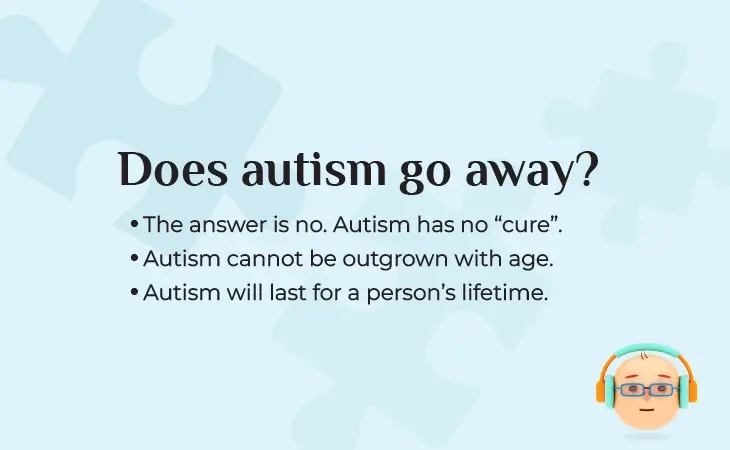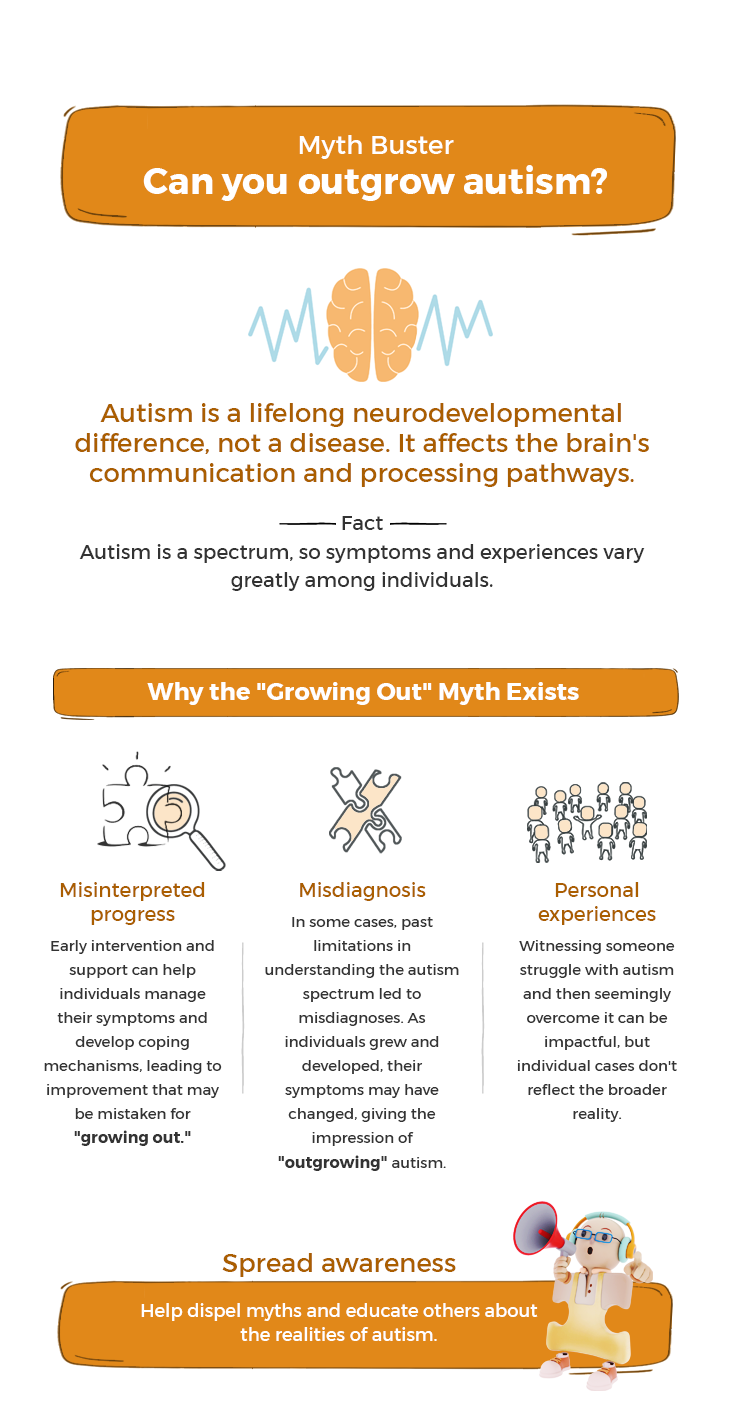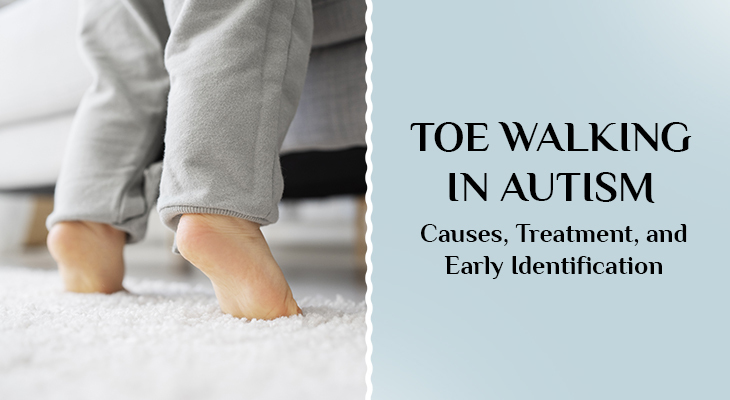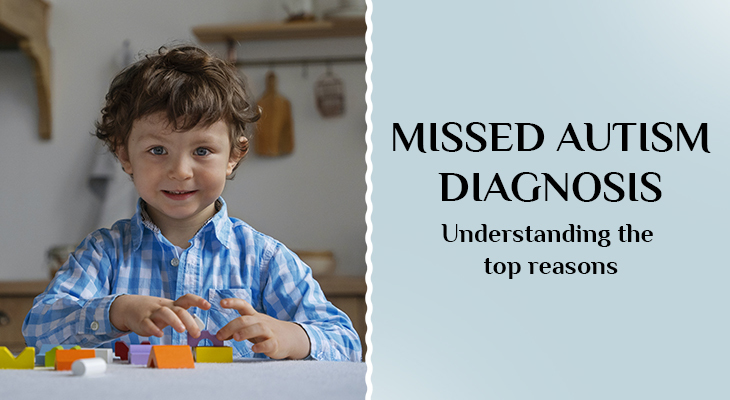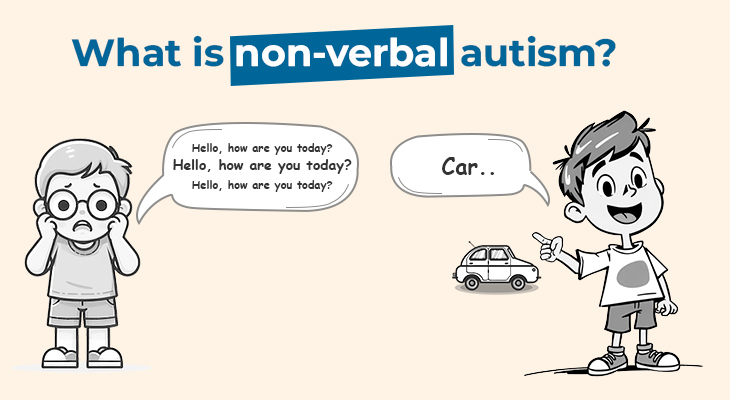Can autism go away with age?
The answer is NO. Autism is a complex neurodevelopmental condition that affects a person’s brain and nervous system, and there’s no single cause or treatment that can completely cure it. Hence autism is not something that can be completely outgrown with age. Like a unique fingerprint, an autism diagnosis will last for a person’s lifetime although therapy & support can help manage symptoms and significantly enhance quality of life.
Remember, when you hear stories of “miraculous cures” promising to cure autism, approach them with caution. Often, they’re exploitative scams preying on vulnerabilities. With dedicated support and tailored strategies, individuals on the spectrum can not only manage the challenges autism presents but also flourish in their own remarkable ways.
Table of Contents
- Can autism go away with age?
- Why do some people think autism can go away with age?
- Role of early intervention
- How Can Therapy Significantly Improve Autism Symptoms?
- Unlocking a New Path: How Folate Deficiency and Autoimmunity Might Link to Autism Severity
- Which autistic children are most likely to improve?
- Conclusion
- Did You Know About Folate Receptor Autoantibodies (FRAAs) and Brain Development?
- References
Why do some people think autism can go away with age?
When it comes to understanding complex matters like autism, separating feelings from facts is crucial. While some people might believe autism disappears with age, these beliefs often stem from personal experiences and emotions, not scientific evidence.
Autism is mainly characterized by learning delays, repetitive movements and behaviors and difficulty with expressive or receptive communication. The challenges associated with autism can be incredibly difficult for families and friends. The desire to see loved ones overcome these challenges may often lead to misinterpretations of progress.
From time to time, we hear about people who seemingly overcome their autistic characteristics, but a closer look reveals a different truth. Some autistic individuals, with early intervention and support, learn to better manage their communication and social skills. This improvement, while real and commendable, can be misinterpreted as “losing” autism, especially in older individuals.
Personal experiences with individuals who seem to “outgrow” autism, however rare, can leave a strong impression and fuel the belief that it’s possible for others too. This can overshadow the broader scientific evidence of autism’s lifelong nature.
Decades of research solidify that autism is a neurodevelopmental difference, not a disease with a cure. The underlying brain variations remain throughout life, even if symptoms evolve and become more manageable.
But sometimes the misconception also arises from an autism misdiagnosis. Some individuals may have been misdiagnosed with autism in childhood, perhaps due to a limited understanding of the spectrum back then. As they grew older and developed coping mechanisms, their early symptoms might have become less apparent, creating the illusion that they’ve “outgrown” their autism.
The idea that autism can vanish with age might also stem from cases where children with autism possess higher IQ and cognitive abilities. These abilities can offer advantages such as a stronger understanding of social cues, effective coping mechanisms and ability to mask symptoms contributing to the misconception that their autism has completely disappeared.
While a 2013 study by NIH found that some children correctly diagnosed with autism spectrum disorders (ASD) at an early age may lose symptoms as they grow older, it’s vital to acknowledge that autism, as of 2024, remains a lifelong condition without a cure.
In conclusion, the belief that autism disappears with age, in most cases, stems from a blend of well-intentioned feelings and an incomplete understanding of autism. Scientific evidence clarifies that while autistic symptoms can be lowered or masked, growing out of it isn’t possible to do with today’s treatment.
Role of Early Intervention in Autism
For children on the autism spectrum hints might appear as early as 8 to 12 months. But therapists typically wait until 18 months when symptoms settle. The brains of such young children are especially flexible, creating more connections and adapting to new things at a rapid pace. This “neuroplasticity” makes early intervention for autistic children particularly effective, as it allows them to readily learn and acquire valuable skills.
Think of the child’s brain like a young sapling. The earlier you provide support and guidance, the stronger and more versatile it can grow. With early intervention, autistic children can develop vital life and social skills that set them up for success.
To dive deeper into the benefits, read our blog on Benefits of Early Intervention in Autism
How Can Therapy Significantly Improve Autism Symptoms?
While there’s no cure and autism does not go away, various therapies and interventions can help minimize symptoms and maximize abilities empowering individuals with autism to lead fulfilling lives.
No two individuals with autism experience it exactly the same way, so the most effective treatment plans are tailored to each person’s specific needs and strengths. While some benefit from highly structured programs, others might thrive with more flexible approaches. The key is finding the right combination of therapies and interventions that empower each individual to reach their full potential.
The following are just a few different therapy types available for autistic kids.
-
Applied Behavioral Analysis (ABA)
ABA focuses on modifying behavior through positive reinforcement and other evidence-based techniques. It assumes that all behavior, including unwanted behaviors, is learned through interactions with the environment. Therefore, it aims to change behavior by influencing the environment and its consequences. The goals of ABA therapy are:
- To learn new skills such as communication, social interaction or emotional regulation
- Reduce challenging behaviors such as injurious behaviors, meltdowns & repetitive movements
- Help individuals with ASD gain independence, improve their quality of life, and integrate fully into their communities.
-
Occupational Therapy (OT)
OT plays a crucial role in supporting individuals with autism spectrum disorder (ASD) by focusing on enhancing their ability to perform activities essential for daily living.
- Daily living skills: OT helps individuals with ASD master tasks like dressing, bathing, eating, and household chores, promoting independence and self-care.
- Social skills: OT can equip individuals with ASD with strategies for effective communication, building relationships, and navigating social situations confidently.
- Fine motor skills: OT can address fine motor challenges like handwriting, buttoning clothes, and using utensils, improving overall coordination and dexterity.
- Emotional regulation: OT can teach individuals with ASD coping mechanisms for managing emotions such as anxiety, frustration, and meltdowns.
-
Sensory Integration Therapy (SIT or SI)
SI is a type of intervention specifically designed to help individuals on the autism spectrum, overcome challenges related to their sensory processing. SI works by using play-based activities and sensory-motor tools.
-
Speech-Language Therapy
Speech-Language therapy addresses difficulties with speech, language comprehension, and expression, improving communication skills and overall functionality.
-
Cognitive Behavioral Therapy (CBT)
CBT helps individuals identify and change negative thought patterns that contribute to anxiety, depression, and other challenges.
-
Other Supportive Autism Therapies
Other therapies such as Art Therapy, Music Therapy and Animal Therapy are also used by therapists to achieve desired outcomes.
Remember – therapists often witness inspiring stories of children with autism developing incredible skills and managing challenges effectively. While sometimes called “recovered” or “indistinguishable” from peers, such progress reflects years of dedicated support and learning coping mechanisms, not an erasure of their autism.
Unlocking a New Path: How a Folate Deficiency and a particular Autoimmunity Might Link to Autism Severity
Autism rates continue to rise in the US, affecting a staggering 1 in 36 children. While the cause remains complex, exciting research shines a light on a potential contributor: cerebral folate deficiency syndrome and its association with a specific autoimmunity. The recent discovery of folate receptor autoantibodies opens doors for early diagnosis and potentially improved symptom management.
-
Focus on Folate:
Folate (vitamin B9) plays a crucial role in brain development and function. Recent studies show that insufficient folate may lead to a condition termed cerebral folate deficiency syndrome, potentially impacting neurodevelopment. A major contributing factor to cerebral folate deficiency syndrome is the presence of folate receptor autoantibodies. These autoantibodies block the folate receptor alpha and constrict proper folate transport into the brain and cerebrospinal fluid. Lack of proper folate into the brain and cerebrospinal fluid may have a negative impact on proper neurological function. Alarmingly, research indicates that many children with ASD have tested positive for folate receptor autoantibodies. This may indicate a correlation between folate receptor autoantibodies, cerebral folate deficiency syndrome and autistic symptoms. Most promising, however, has been that this specific population (those that have tested positive for folate receptor autoantibodies), has responded positively to folinic acid (a reduced folate that is able to bypass the blocked folate receptor alpha), resulting in improved speech, behavior, and communication skills. This is a very exciting development!
-
Hope through Diagnosis and Treatment:
A simple test termed FRAT® can detect the presence of these folate receptor autoantibodies, leading to a personalized treatment plan. By providing alternate forms of folate, such as folinic acid that bypass the blocked receptors, one can potentially minimize the impact of cerebral folate deficiency syndrome and reduce the severity of some autistic symptoms in those patients that have folate receptor autoantibodies. As with any medical condition, a physician’s diagnosis and authorization is required. Please reach out to your medical professional and discuss this very important subject.
Which autistic children are most likely to improve on their symptoms?
It’s not possible to predict with certainty which autistic children will improve on their symptoms and to what extent. But observations suggest that significant improvement is most likely in autistic kids with low support needs, and whose autism traits or diagnosis does not include seizures, speech delay, learning disabilities, or extreme anxiety. Autistic individuals with more neurotypical IQ scores, spoken language skills, and other existing strengths are most likely to show advancement.
Autism is a complex spectrum disorder, and each individual’s experience is unique, making it difficult to generalize about potential for improvement. Certain factors can be associated with a higher likelihood of positive outcomes:
- Early Intervention: Receiving comprehensive services and targeted therapies like those mentioned above as early as possible can significantly enhance outcomes and maximize long-term development.
- Cognitive Abilities: Children with higher cognitive scores tend to experience greater improvements in language and adaptive skills compared to those with lower scores. However, cognitive ability is not the sole determining factor, and individuals with lower scores can still thrive with appropriate support.
- Severity of Symptoms: Generally, children with less severe symptoms and fewer challenging behaviors may exhibit greater improvement compared to those with more significant challenges. However, this doesn’t diminish the potential for progress in all cases.
- Family Support: A strong and supportive family environment that actively participates in therapeutic interventions and provides consistent care can positively impact the child’s progress and well-being.
- Access to Quality Resources: Having access to a team of qualified professionals, specialized programs, and adequate resources can contribute significantly to positive outcomes.
Conclusion
While autism remains a lifelong companion for individuals on the spectrum, it doesn’t define their future. The misconception of “growing out” of autism often stems from a blend of well-intentioned hope and incomplete understanding. However, focusing solely on this false hope can overshadow the incredible progress possible through dedicated support and early intervention.
Remember, autism is a spectrum, not a single point. Each individual experiences it uniquely, with varying strengths and challenges. While complete “cures” may not be readily available, a wealth of therapies and interventions exist to empower individuals with autism to manage symptoms, develop valuable skills, and lead fulfilling lives.
Early intervention plays a crucial role in unlocking the potential of autistic children. Their young brains are remarkably adaptable, making them receptive to learning and skill development. By providing tailored support, we can help them navigate the challenges of autism and build confidence in their unique abilities.
Remember, the journey is not about “erasing” autism, but about embracing its unique complexities and fostering the potential within every individual on the spectrum.

